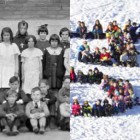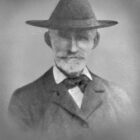Then & Now
St.Albert City Growth
May, 2025
In 1861, on a snow-covered hilltop overlooking the Sturgeon River, Bishop Tache was impressed by the spot that Father Albert Lacombe had chosen to build a mission. “This site is magnificent,” Tache said to the priest. “I choose it for a new mission and I want it to be called St. Albert, in honor of your patron saint.” In roughly 150 years, St. Albert morphed from a community of 10 houses to a city of more than 70,000 people that now covers nearly 48 square kilometres. Here’s a brief look at how it grew.
1860s-1870s
After establishing a mission site, Lacombe drew up 30 lots for settlers based on Quebec’s seignorial system. Lots were primarily narrow strips of land (some stretching as far as five kilometres) with easy access to the Sturgeon’s northern banks.
By 1870, nearly 1,000 people inhabited the area, many of them local Metis and families from Manitoba’s Red River Settlement. Most struggled with smallpox, poor crop yields, and declining buffalo herds. Still, the people kept coming, spurred by the federal government’s 1972 passage of The Settlement Act, offering arrivals a quarter-section of land for a $10 registration fee.
1880s-1890s
Almost every parcel of land between St. Albert, Edmonton and Fort Saskatchewan had been snapped up by 1882. But these land grabs often led to border disputes between owners in what The Edmonton Bulletin dubbed as “claim jumping.” Surveys finally registered in 1884 sorted out that mess and created 61 new river lots, including 15 on the Sturgeon’s southern banks as St. Albert’s growth finally traversed the river.
In 1890, the Catholic Church campaigned to attract French Canadian settlers, but with little homestead land left, many arrivals opted to live in nearby communities like Morinville and Villeneuve. By 1899, occupying what is now the downtown area and Mission, its first official neighbourhood, the settlement was granted village status.
1900s-1940s
Pegged by a 1901 census as a village of 472 residents, St. Albert had already expanded northwest a year earlier, taking up land that would become the southern parts of the Braeside and Inglewood neighbourhoods. By 1906, a year after Alberta became a province, St. Albert was officially declared a town with 543 residents.
Thanks in part to access to a national railway, business was booming with hotels, general stores and banks joining established services from blacksmiths to pool halls. “There is no other town of
this size in the province in a postition [sic] to offer better opportunities to investors, business men, and in fact practically all lines of industry, than is St. Albert,” crowed an ad placed by the town in the Edmonton Bulletin in 1908.
With barely 600 residents in 1913, St. Albert annexed property in all directions, expanding the town’s size from 248 hectares to nearly 1,300. But on nine occasions between 1920-1949, the town had to withdraw much of that land. One case in 1939 involved the provincial Board of Public Utility Commissioners abiding by a withdrawal application by former St. Albert entrepreneur Raymond Brutinel, who at one time owned up to 20,000 hectares in the region. By the dawn of the ’50s, the town occupied less than 500 hectares, absorbing parts of what is now Forest Lawn, Grandin, and Sturgeon Heights.
1950s-1960s
The mid-century saw St. Albert’s population rapidly pass the 1,000 mark, due to the discovery of oil in Leduc in 1947, and a wave of commuter-minded citizens in nearby Edmonton moving to the town. However, those arrivals taxed the capacity of available utilities and considerably drained town coffers.
To remedy the situation, St. Albert declared itself as a New Town in 1957 to get access to funding provided by the provincial government’s New Town Act. The money enabled the town to annex land eastward, enlarging Braeside and Forest Lawn, and creating the neighbourhood of Akinsdale.
St. Albert was in a festive mood when celebrating its centennial as a community of some 4,000 residents in 1961, and annexing land that expanded the size of Grandin, but that vibe disappeared the following year when the provincial government rescinded its New Town status. St. Albert was still broke, despite its distinction of being Alberta’s largest town.
By 1968, movers and shakers in the town, boasting more than 10,000 residents, started to consider an amalgamation with rapidly-expanding Edmonton to solve its financial woes.
1970s-1990s
Throughout the ’70s, the idea of St. Albert succumbing to Edmonton expansion withered once town finances slowly crept back into the black. Persuading home developers to foot the bill for neighbourhood infrastructure greatly reduced expenses, also resulting in residents enjoying lower taxes than folks in Edmonton. Symbolic of a determination to hold its own against the Alberta capital’s expansion aspirations, in 1975, St. Albert annexed more land eastward that would become the neighbourhoods of Kingswood, Pineview, and Woodlands.
Civic pride exploded when St. Albert, boasting a population of nearly 25,000, achieved city status in 1977. It was enough to deter Edmonton’s 1979 annexation bid to absorb St. Albert, as locals defiantly protested the proposal with an aggressive “Beat the Bounds” campaign, forcing its metropolitan aggressor to exclude the new city from its plans in 1982.
During that debacle, St. Alberta embarked on a mammoth annexation initiative involving 1,500 hectares of property. By 1980, it had acquired areas that involved the expansion of Deer Ridge, Erin Ridge, and Riverside, as well as territory that would become the Campbell Business Park, North Ridge, Oakmount, Ville Giroux. Three smaller annexation phases filled in some geographic gaps later that decade.
2000-Today
Since becoming a city, St. Albert’s population doubled, reaching more than 53,000 by 2001. That rapid growth prompted a major annexation northwest in 2007, creating neighbourhoods that included Avenir, Cherot, Jensen Lakes, and the second phase of North Ridge.
In 2022, an additional 2,100 hectares of land in Sturgeon County north of St. Albert was officially annexed by the city. “I hope that as new residents you take advantage of everything the
city has to offer and immerse yourself in our rich history and vibrant culture,” said St. Albert Mayor Cathy Heron during a publicly-streamed session in February that year.
Although not an expansionist decision, but one of major cultural significance, St. Albert city council voted in March to change the name of the Grandin neighbourhood to The Gardens, effective Sept. 1.













